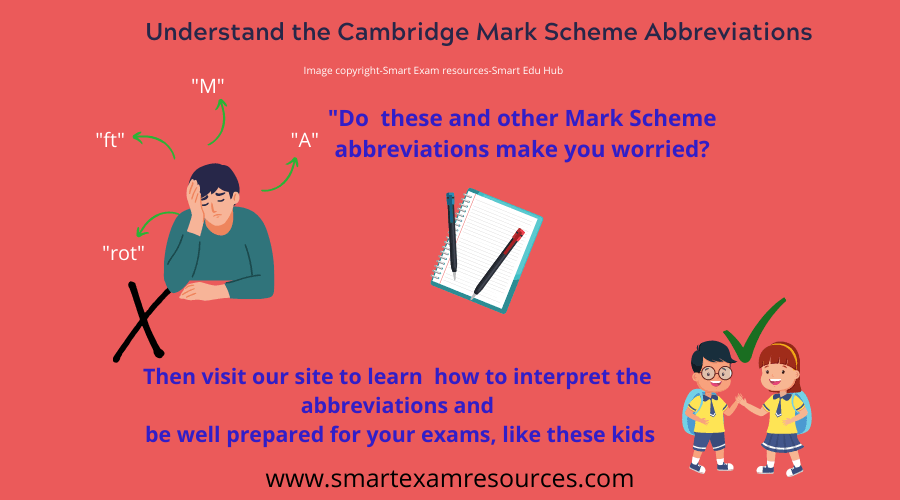 Download PDF
Download PDF
Cambridge IGCSE Mark Scheme Abbreviations

Mark Scheme Abrreviations :
Cambridge IGCSE makes use of various short forms [ abbreviatioms] in their mark schemes. These abbreviations have distict meaning and are sometimes tricky to understand. Having a knowledge of the abbreviations helps to understand the way your exam papers are assessed . Here is a common list of abbreviations we found that you will find useful
Importance of Mark Scheme Abbreviations:
- Marking Scheme Abbreviations by Cambridge , keep you informed about the assessement criteria.
- Help you prepare keeping the board exams in mind
- Make you understand ways of improving your scores
- Reduce nervouness after each exam, As the marking schemes have something called as the e.c.f , for instance, which ensures that you do not end up getting a " zero" for a wrong answer.
Over-dependence on IGCSE Solved Past Papers: Also it is a common observation that most students are over-dependent on the Model Solutions or Solved Past Papers Or Board Exam Solutions, what ever you may call it. The reason I am saying this is because, what the model solution gives you is only one type of an answer accepted by Cambridge. It is a well known fact that no two people think alike and hence Cambridge gives the option of alternate vocabulary wherever possible. And if you never learn to interpret the mark schemes, you will never be able to understand what Cambridge is expecting out of you for a particular subject. The marking schemes not only guide you with the alternative vocabulary, but they also give you an insight on the bifurcation of marks per question, be it a multiple choice questions, structured question or alternative to practical. Also mark schemes make use of codes all throughout the paper. You must learn how to interpret the codes. The following is a subject wise list of codes that you need to learn to interpret
Learner's Guide: So now that you know to interpret the codes, you might want to start answering questions, but wait. One more thing you need in your kit is the Learner's guide, This is released by Cambridge and is available for free down in our members area. This learner guide tells you the exact way of answering as per various command words. Also its is a beautiful document that has sample solved papers by Cambridge itself, so what more can you expect ever! So make things your guiding light for every subject..And finally you may begin answering the questions. Now here is a personal advice based on my 10 + years of teaching Cambridge syllabus and that is" Please do not look at the marks and write those many bullet points. Also do not write contrasting statements in the same answer. Do not write the same things in different words as a second point. Every point needs to be unique. Look at the available space and try to fit in your answer. remember the Cambridge experts have years of experience and know exactly how much space will be needed for each answer.

Following are the Mark Scheme Abbreviations for IGCSE Physics/Chemistry/Mathematics and Biology
Biology 0610 Mark Scheme Abbreviations
Abbreviations used in the Mark Scheme
- ; separates marking points •
- / separates alternatives within a marking point
- R reject
- ignore mark as if this material was not present •
- A accept (a less than ideal answer which should be marked correct)
- AW alternative wording (accept other ways of expressing the same idea)
- underline words underlined (or grammatical variants of them) must be present
- wiggly underline the idea conveyed by the word(s) underlined must be present in the answer
- max indicates the maximum number of marks that can be awarded
- mark independently the second mark may be given even if the first mark is wrong
- ecf credit a correct statement that follows a previous wrong response
- ( ) the word / phrase in brackets is not required, but sets the context
- ora or reverse argument
- AVP any valid point
Chemistry 0620 Mark Scheme Abbreviations
Abbreviations used in the Mark Scheme
- ; separates marking points • / separates alternatives within a marking point
- () the word or phrase in brackets is not required but sets the context
- A accept (a less than ideal answer which should be marked correct)
- I ignore (mark as if this material were not present)
- R reject
- ecf credit a correct statement that follows a previous wrong response • ora or reverse argument
- owtte or words to that effect (accept other ways of expressing the same idea)
Back to top of the page
Physics 0625 Mark Scheme Abbreviations
NOTES ABOUT MARK SCHEME SYMBOLS & OTHER MATTERS
- B marks are independent marks, which do not depend on other marks. For a B mark to be scored, the point to which it refers must be seen specifically in the candidate’s answer
- M marks are method marks upon which accuracy marks (A marks) later depend. For an M mark to be scored, the point to which it refers must be seen in a candidate's answer. If a candidate fails to score a particular M mark, then none of the dependent A marks can be scored.
- C marks are compensatory marks in general applicable to numerical questions. These can be scored even if the point to which they refer are not written down by the candidate, provided subsequent working gives evidence that they must have known it. For example, if an equation carries a C mark and the candidate does not write down the actual equation but does correct substitution or working which shows he knew the equation, then the C mark is scored. A C mark is not awarded if a candidate makes two points which contradict each other. Points which are wrong but irrelevant are ignored.
- A marks A marks are accuracy or answer marks which either depend on an M mark, or which are one of the ways which allow a C mark to be scored. A marks are commonly awarded for final answers to numerical questions. If a final numerical answer, eligible for A marks, is correct, with the correct unit and an acceptable number of significant figures, all the marks for that question are normally awarded. It is very occasionally possible to arrive at a correct answer by an entirely wrong approach. In these rare circumstances, do not award the A marks, but award C marks on their merits. An A mark following an M mark is a dependent mark.
- Brackets ( ) Brackets around words or units in the mark scheme are intended to indicate wording used to clarify the mark scheme, but the marks do not depend on seeing the words or units in brackets, e.g. 10 (J) means that the mark is scored for 10, regardless of the unit given. Underlining Underlining indicates that this must be seen in the answer offered, or something very similar.
- OR / or This indicates alternative answers, any one of which is satisfactory for scoring the marks.
- e.e.o.o. This means "each error or omission".
- o.w.t.t.e. This means “or words to that effect”.
- Ignore This indicates that something which is not correct or irrelevant is to be disregarded and does not cause a right plus wrong penalty.
- Spelling Be generous about spelling and use of English. If an answer can be understood to mean what we want, give credit. However, do not allow ambiguities, e.g. spelling which suggests confusion between reflection / refraction / diffraction or thermistor / transistor / transformer.
- Not/NOT This indicates that an incorrect answer is not to be disregarded, but cancels another otherwise correct alternative offered by the candidate, i.e. right plus wrong penalty applies.
- ecf meaning "error carried forward" is mainly applicable to numerical questions, but may in particular circumstances be applied in non-numerical questions. This indicates that if a candidate has made an earlier mistake and has carried an incorrect value forward to subsequent stages of working, marks indicated by ecf may be awarded, provided the subsequent working is correct, bearing in mind the earlier mistake. This prevents a candidate from being penalised more than once for a particular mistake, but only applies to marks annotated ecf.
- Significant Answers are normally acceptable to any number of significant figures > 2. Any figures exceptions to this general rule will be specified in the mark scheme.
- Units Deduct one mark for each incorrect or missing unit from an answer that would otherwise gain all the marks available for that answer: maximum 1 per question.
- Arithmetic errors Deduct one mark if the only error in arriving at a final answer is clearly an arithmetic one. Regard a power-of-ten error as an arithmetic error.
- Fractions Allow these only where specified in the mark scheme.
- Abbreviations cao correct answer only cso correct solution only dep dependent ft follow through isw ignore subsequent working oe or equivalent SC Special Case soi seen or implied www without wrong working
- Back to top of the page
Mathematics ( 0580) /Additional Math (0606) / Cambridge International Math (0607)Mark Scheme Abbreviations
- cao correct answer only
- cso correct solution only
- dep dependent
- Ft follow through after error
- isw ignore subsequent working
- oe or equivalent
- SC Special Case
- soi seen or implied
- www without wrong working
- rot rounded or truncated
- awrt answers which round to
- nfww not from wrong working
- M1 method mark (M2, etc, is also used)
- A1 accuracy mark
- B1 independent mark
- E1 mark for explaining
- U1 mark for correct units
- G1 mark for a correct feature on a graph
- M1 dep* method mark dependent on a previous mark,
- Note:
- Mark Scheme abreviation knowledge is important .
- It helps you understand how marks are allotted as awell as deducted.
Back to top of the page
Next
Previous

Write a public review